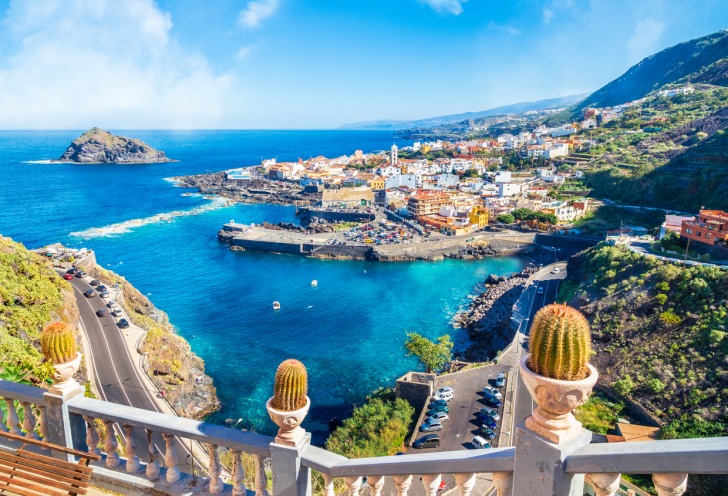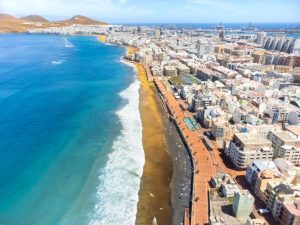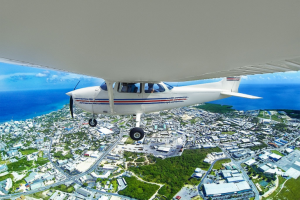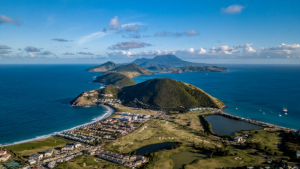 Spain : Safety by City
Spain : Safety by City
- Alicante
- Andorra la Vella
- Barcelona
- Bilbao
- Cadiz
- Canary Islands
- Granada
- Ibiza
- Las Palmas
- Madrid
- Malaga
- Murcia
- Palma de Mallorca
- Pamplona
- Salamanca
- San Sebastian
- Seville
- Valencia
- Zaragoza
Comprising seven islands, the Canary Islands are only 62 miles west of Western Sahara and Morocco.
Although a small archipelago, the Canaries are home to 2.2 million people, making them the most populated special territory of the European Union.
Most of the population is concentrated in Tenerife and Gran Canaria.
The largest city, Las Palmas, is in Gran Canaria.
Due to the island’s location, they have historically been considered a link between Europe, South America, North America, and Africa.
The islands have a vibrant culture and rich history, along with one of the best beaches in Spain, thus making them a popular global tourist destination.
Las Palmas is a captivating city with plenty of historical sites, outdoor adventures, fantastic nightlife, and exceptional food representing the island’s diversity.
If you’re considering traveling to the Canary Islands, it’s essential to understand the potential dangers, safest and least safe locations, best safety tips, and other relevant information before leaving.
Keep reading to learn more about this paradise!
Warnings & Dangers in Canary Islands

OVERALL RISK: LOW
The crime rate in the main city and across all islands is low, making it a safe destination for visitors regardless of the time of day or night. Travelers shouldn't be worried about walking the streets at night, even alone. However, like in any location, you must remain vigilant and leave an area if you don't feel safe.

TRANSPORT & TAXIS RISK: LOW
Metered taxis and ride-sharing are plentiful on the two main islands. However, taxis aren't as prevalent on smaller islands with a lower population, so you may need the hotel to call. Taxis are a safe choice in all locations since there are many fixed transportation rates. The only mass transit on the islands is the bus, which is also safe at all hours of the day or night. While the bus is a good option within cities, getting to specific locations outside of city limits will be difficult.

PICKPOCKETS RISK: HIGH
Spain generally has a pickpocketing problem due to high unemployment rates, and the Canary Islands are no exception. Purse snatching is common in Las Palmas, especially during festivals, holidays, and weekends when more visitors are present. Also, Las Palmas has issues with car break-ins, so it's critical always to keep belongings in sight. Thieves are most active near airports, hotel lobbies, and on beaches.

NATURAL DISASTERS RISK: LOW
The Canaries have a minimal risk for major storms like hurricanes, and experts calculate less than a two percent chance of a damaging earthquake in the next 50 years. Wildlife hazards on the islands are also low, but if you see a wild animal, it's best to take photos from a distance and never attempt to feed them. The islands get thunderstorms and lightning, which can cause flooding, but it's a minimal risk for visitors.

MUGGING RISK: LOW
Although car break-ins and pickpockets are prevalent, violent crimes are almost nonexistent, including mugging and robbery. Although this is not a concern, it's important to keep your guard, stay on well-lit streets, leave valuables at home or out of sight, and not draw unwanted attention to yourself.

TERRORISM RISK: MEDIUM
Europe is always a target for terrorists due to certain political views. While the Canary Islands have not yet been a target, they are a popular tourist destination, so the risk of an attack is always medium. An attack on mainland Spain is more likely, but it's essential always to be aware of your surroundings and report any suspicious activity, especially in public areas.

SCAMS RISK: MEDIUM
ATM and credit card fraud is common in the Canary Islands, so use banks or reputable ATMs, not those randomly on the street. Also, pay attention when others are handling your credit cards, as you never know when they can be swapped. Additionally, Internet scams via email citing business opportunities and other amazing deals are common, although they are unlikely to impact tourists.

WOMEN TRAVELERS RISK: LOW
The Canary Islands are safe for solo female travelers since crime rates are low and women are well-respected by most. Although it is safe to walk alone at night, it's still important to be aware of your surroundings and pay extra attention to your belongings, as pickpocketing and scams are common on the Islands.

TAP WATER RISK: LOW
Spain and the Canaries have excellent tap water that's safe to drink from the faucet. This means you don't need to take precautions as they are similar to your home. The only questionable water comes from private wells and unregulated water sources in rural areas. Still, bottled water is inexpensive and readily available everywhere if you want to be completely cautious. When staying in cities, bringing a water bottle to refill with excellent tap water is always beneficial to save money.
Safest Places to Visit in Canary Islands
The safest areas on the islands are rural, less populated towns and villages.
In Las Palmas, the safest places are closest to Las Canteras Beach, such as Guanarteme, El Puerto, La Puntilla, and La Isleta.
Las Canteras is one of the top beaches in the country and in Western Europe.
Other safe areas include Triana and Vegueta.
Places to Avoid in Canary Islands
Generally speaking, the Canary Islands are safe, minus petty crimes that are primarily opportunistic.
Walking around during the day and night is achievable without major concern.
The only area to avoid is Santa Catalina Park in Las Palmas at night.
Also, Isleta and Jinamar are not the most welcoming places for tourists, so there’s no reason to visit.
Furthermore, avoid alleys in Las Palmas and Tenerife as they are dark and could have criminals waiting for someone to make a wrong turn.
For those who wish to avoid crowds, Maspalomas and Playa del Ingles have heavy foot traffic and are common places for pickpockets.
The best way to avoid becoming a crime victim is to stay away from nightlife areas as they are more active with thieves at night.
Using common sense goes a long way while traveling, and the Canary Islands are no exception, regardless of their excellent safety record.
Safety Tips for Traveling to Canary Islands
- Always Use a Metered Taxi. Although unlicensed taxis are not a significant problem in cities, they still exist. If you get into a taxi and don’t see a meter, then politely exit the car, as they can charge whatever they want since it’s unregulated. This will save you a massive headache and could save you a lot of money.
- Avoid Demonstrations. All areas of Spain have regular demonstrations at government buildings, and the Canaries are no exception. Luckily, most demonstrations and protests are nonviolent, but you never know when one can quickly escalate and get out of hand. Given that this isn’t your fight, avoid large groups of people unless it’s a parade!
- Don’t Hike or Camp Alone. Although the Canary Islands are small, getting lost or injured is easy, so always hike or camp with a buddy. If you must go into the wilderness alone, always contact the local ranger’s office and give them your route and time when you plan to check back in at the end of your adventure.
- Keep An Eye on Your Belongings. This point is crucial for visiting markets, festivals, beaches, and other busy areas. Pickpockets and thieves are looking for easy targets who leave their bags only for a moment, so don’t be a victim by being vigilant with your belongings.
- Know the Basic Emergency Numbers. Before traveling to the Canary Islands, search for and enter local emergency numbers into your phone and on paper so they are readily available. These include your country’s embassy or consulate, emergency police or fire, and the ambulance service.
- Leave the Valuables at Home. Like in all destinations, petty crime is common in tourist-frequented neighborhoods and attractions. The Canary Islands, specifically Lanzarote, Fuerteventura, Gran Canaria, and Tenerife are no exception to pickpocketing. Avoid running into this issue on your dream vacation by storing valuables in your hotel room. Also, never bring your passport in public and leave it locked away in your room in a safe or lockable luggage bag when out for the day.
- Never Ignore Beach Flags. With over 60 beaches receiving the Blue Flag award, the Canary Island beaches are some of the safest on Earth. Lifeguards regularly patrol the beaches and look for hazards to keep visitors safe. There are several flags you must know before visiting, each with a different hazard, including the following: • Red – strong currents unfit for swimming. • Yellow – modern currents or surf, swim cautiously. • Green – calm conditions, exercise caution. • Purple–shark, stingray, and jellyfish sightings. Always follow these beach flags, and if you need clarification on whether it’s safe to swim, ask a lifeguard on duty.
- Never Wander Down Dark Alleys. While cutting through a dark alley may be a slightly faster route, you never know who is waiting for an unsuspecting wanderer. This is especially important in Las Palmas and Tenerife to avoid any conflicts.
- Only Drink in Marked Areas. Vaping, smoking, and drinking in public places are prohibited on the streets or beaches of the Canary Islands. While this isn’t a safety tip, it can save you from a hefty fine. Instead, find a café, restaurant, or bar with an outdoor seating area with a designated smoking section. Here, you can drink and smoke while enjoying the beautiful outdoor weather.
- Pay Attention if a Stranger is Asking Questions. If a stranger approaches you asking many questions, be aware of someone behind you attempting to steal your wallet, open your bag, or conduct some other petty crime. Always keep your belongings in the front pocket and your bag at the front of your body. Also, politely say you don’t know and leave the situation.
So... How Safe Is Canary Islands Really?
The Canary Islands are one of the safest places to visit in Europe.
The latest statistics show that the overall crime rate has been at the lowest level since 2010, which is impressive since most places experienced crime upticks during and following the pandemic.
The crimes that occur in the Canary Islands are mostly petty thieves and property damage, so there is nothing to worry about when visiting.
Las Palmas, the largest city, has a combined crime rate of only 41.2 incidences per one thousand individuals.
The best way for visitors to remain protected is to leave valuables in a safe in the hotel room or locked in luggage.
Also, don’t carry your wallet or phone in your back pocket as it can easily be stolen.
The daytime safety rating for those walking alone is an exceptional 86.49; at night, it’s 67.74, which is still impressive.
The best defense against petty crimes is being aware of your environment, including who is near you.
How Does Canary Islands Compare?
| City | Safety Index |
|---|---|
| Canary Islands | 81 |
| Andorra la Vella | 89 |
| Madrid | 68 |
| Barcelona | 67 |
| Valencia | 69 |
| Seville | 71 |
| Bilbao | 52 |
| Sofia (Bulgaria) | 73 |
| Siem Reap (Cambodia) | 63 |
| Phnom Penh (Cambodia) | 61 |
| Niagara Falls (Canada) | 87 |
| Calgary (Canada) | 82 |
| Buenos Aires (Argentina) | 60 |
Useful Information

Visas
For those traveling to the Canary Islands or anywhere in Spain, most don't require a visa for stays less than 90 days. Visa requirements can be found on each embassy's website, along with any other entrance requirements.

Currency
The main currency in Spain is the Euro since it's part of the European Union. Given the amount of tourism, especially in the summer, credit cards are accepted in most places, even rural villages. ATMs are plentiful, and currency exchange shops can also be found.

Weather
Unlike the rest of Spain, which is more arid, the Canaries boast a tropical climate with temperatures ranging throughout the year. Average temperatures in January are around 69 degrees F and rise to 83 degrees F in the summer. Most visitors get away with summer or spring attire throughout the year, so colder temperatures are rare.

Airports
The main airport servicing Las Palmas and the island is Fuerteventura. Visitors can hop on the airport bus to the city center, which takes around 35 minutes. Additional airports include Lanzarote, Gran Canaria, Tenerife South, and Tenerife North, depending on which island is your destination.

Travel Insurance
Signing up for travel insurance is necessary regardless of where you are visiting. Travel insurance covers you financially for: • Accidents and personal liability • Legal fees • Lost baggage or days due to airline delays • Medical expenses • Money, passport, and travel documents
Canary Islands Weather Averages (Temperatures)
Average High/Low Temperature
| Temperature / Month | Jan | Feb | Mar | Apr | May | Jun | Jul | Aug | Sep | Oct | Nov | Dec |
|---|---|---|---|---|---|---|---|---|---|---|---|---|
| High °C | 20 | 20 | 21 | 22 | 23 | 26 | 28 | 28 | 27 | 26 | 23 | 21 |
| Low °C | 15 | 15 | 15 | 16 | 17 | 19 | 21 | 21 | 21 | 20 | 18 | 16 |
| High °F | 68 | 68 | 70 | 72 | 73 | 79 | 82 | 82 | 81 | 79 | 73 | 70 |
| Low °F | 59 | 59 | 59 | 61 | 63 | 66 | 70 | 70 | 70 | 68 | 64 | 61 |
Spain - Safety by City
| City | Safety Index |
|---|---|
| Alicante | 77 |
| Andorra la Vella | 89 |
| Barcelona | 67 |
| Bilbao | 52 |
| Cadiz | 74 |
| Canary Islands | 81 |
| Granada | 58 |
| Ibiza | 82 |
| Las Palmas | 74 |
| Madrid | 68 |
| Malaga | 76 |
| Murcia | 83 |
| Palma de Mallorca | 57 |
| Pamplona | 81 |
| Salamanca | 59 |
| San Sebastian | 56 |
| Seville | 71 |
| Valencia | 69 |
| Zaragoza | 79 |











